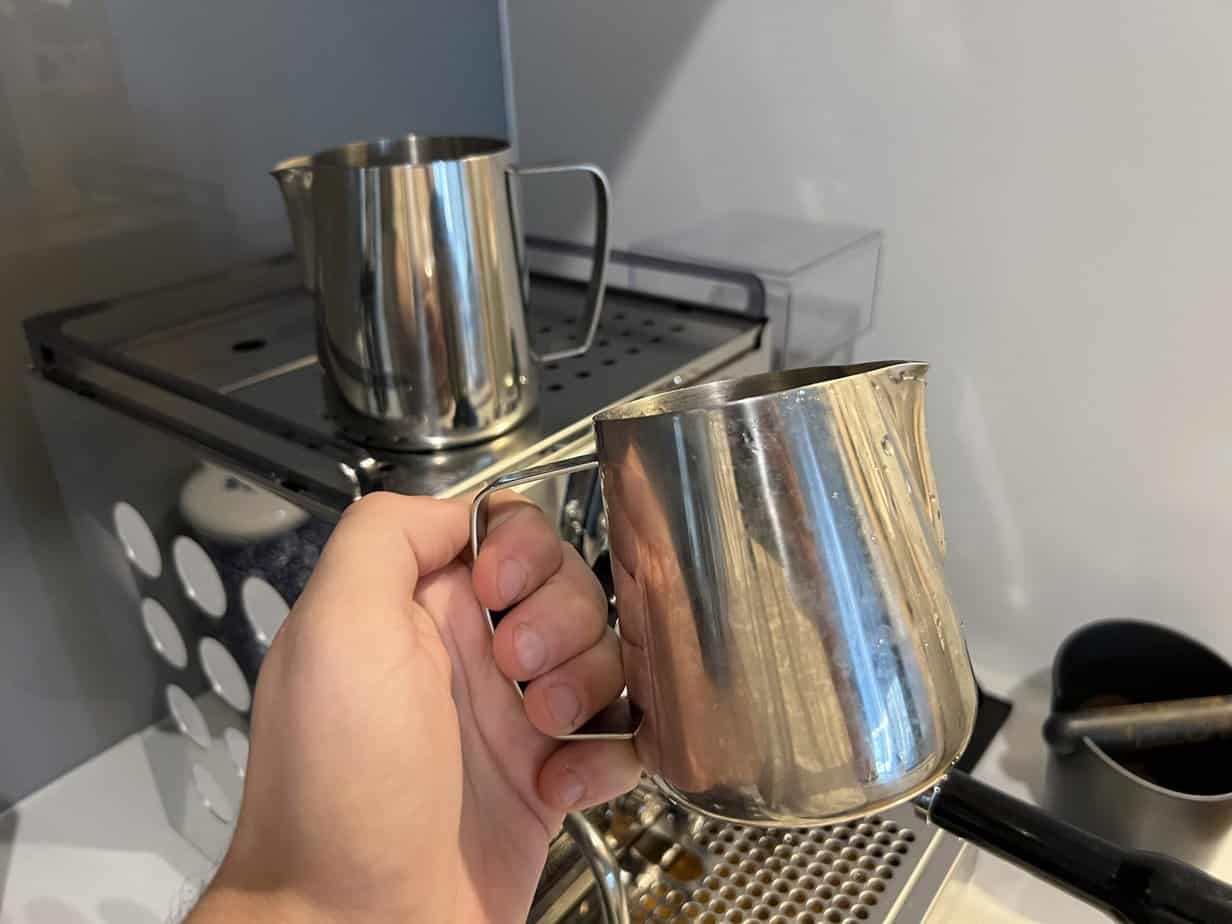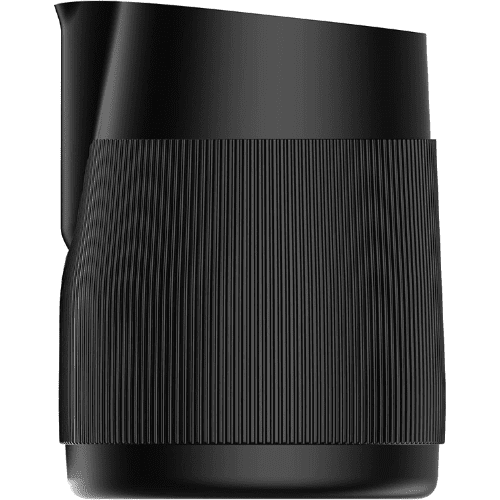When it comes to making latte art one of the most important tools in your arsenal is the milk pitcher. In order get the crispest lines and nicest pours the shape of your milk jug matters. In this post I'll be giving my barista's opinion on the best latte art pitcher for coffee art. This blog is called "Latte Art Guide" for a reason, so I know a thing or two about pitchers.

My latte art frothing pitcher.
I'll start off with my top recommendation, then provide two good alternatives based on your pour style and jug grip, before explaining what makes a good latte art pitcher and how many you need.
Top pick
If you're just starting out with latte art, you don't need to spend a lot of money. Learn how to steam great milk and you will find that a well-priced jug like the Rhino can produce good results. That's why it's the best milk pitcher for latte art.
Flow control option
Symmetry and flow control. This is what makes great latte art. If you are having trouble with these elements, you should try out the Eddy. It's uniform shape and long spout provides superior control when pouring latte art.
No handle
If you are the type of person that doesn't use the handle when pouring latte art, then it's time to get rid of it altogether with the Normcore Handle-less pitcher.
How We Decided
I've used many different milk jugs in my years as a barista. During this time I've come to learn what types of shapes and sizes are best for making latte art. So for this guide I drew on my own person experiences. But I also looked at types of jugs my peers used at work at home, and also researched several reddit and coffee forum posts to find the best milk frothing pitcher for latte art.
Best Latte Art Pitcher
- Top pick: Rhino Milk Pitcher
- Flow control: Fellow Eddy Steaming Pitcher
- No handle: Normcore Handleless Milk Pitcher
Top pick
What we like
Cheap
Comes in range of colors
Well made
Measuring lines
Specifications
Sizes: 12 oz (350 ml), 20 oz (600 ml), 32 (950 ml)
Build: stainless steel
Spout: round
At the end of the day, the type of latte art you can produce comes down to the barista. A good barista should be able to use any type of milk pitcher to produce great designs and become used to the quirks of a particular jug.
That's why when just starting out with making latte art, I recommend you get a basic but well-made Rhino milk pitcher. Buying a more expensive milk jug won't magically help you make better latte art.
Once you have learnt how to steam good milk for latte art and got the basic patterns down, then you can consider if some of the below options I recommend better suit your pouring style. E.g. if you are having trouble with flow control, consider the Eddy. Or if you don't use the pitcher handle as it gets in your way, grab the Normcore that doesn't have one.
Buying an espresso machine, grinder, and accessories is expensive, so the Rhino is a great milk pitcher to get started with latte art. Also the Rhino comes in a wide range of colors to match your kitchen set up, which I find cool.
Flow control option
What we like
Long spout has steady milk flow
Handle is easy to hold
Measuring dots
Symmetrical build
Specifications
Sizes: 12 oz (350 ml), 18 oz (530 ml)
Build: stainless steel
Spout shape: fluted spout
When it comes to pouring latte art one of the most important aspects is having a consistent pour speed - aka "flow". Having good flow allows you to create even shapes and waves to create uniform designs.
The Fellow Eddy seeks to make this easier by designing their jug to have an extra-long spout. The spout allows the milk to travel a greater distance compared to standard jugs. This makes it easier to control the speed and flow of the milk. The jug also has a sharp crease from the centre of the jug to the spout that also assist in controlling the flow of the milk.
The other thing I really like about the Eddy is that it is symmetrical. But aren't all milk jugs symmetrical? Sadly not. Some milk jugs that are built in mass have less quality control so you will find that the spouts are not even. Have a look at the jug you have at home, one side of the jug may be wider than the other. Uneven spouts create uneven designs. Symmetry is a big selling point for me.
So, if you have issues with pouring speed or are finding that your designs are as symmetrical as they should be, then this milk jug is one to consider as it will improve your flow and designs. You will find that your tulips will come out more even and rosetta lines uniform.
No handle
What we like
No handle for easy hold
Makes good waves
Black color
Specifications
Sizes: 15 oz (450 ml), 20 oz (600 ml)
Build: stainless steel
Spout: round & sharp
Do you find yourself holding onto normal jugs with your thumb and index figure. Do you feel that the handle gets in your way from making even jiggles. Then get rid of the handle all together!
The Normcore handle-less milk jug is just that, a jug without a handle.
Depending on how you pour your latte art this handle-less jug may improve the type of latte art you can produce. I personally find it easier pouring slow rosettes with thick lines with a jug with no handle. If you haven't tried this type of jug, then I recommend giving it a go to see if it suits your style.
Latte Art Milk Pitcher Buying Guide
When it comes to selecting a milk steaming pitcher there are a few considerations you need to make: shape of the spout, size of the jug, and quantity of milk jugs.
In this guide I will now discuss these three factors to help you understand what makes the best pitcher for latte art.
Shape of Milk Pitcher Spout for Latte Art
One of the key differences between latte art milk pitchers is the shape of the jug spout. There are two main types of spout shapes to choose from: round and sharp.
Round spouts
Round spouts are the most common type of spouts as they are "all rounders". You can use them to produce any design, but they excel at designs that are more "flowing" like rosettes and tulips. This is because more milk flows out of the jug that allows you to create leaves much easier.

Round spout milk pitcher.
Pointed or sharp spouts
Pointed or sharp spouts on the other hand restrict the flow of the milk and create thinner pour lines. This makes them better to use when pouring complex designs that require thin lines such as a phoenix or scorpion. You can still create these types of designs with round spouted jugs, but what you will find is that the designs are a little fatter.
Which jug spout is better? Round or Pointed?
At the end of the day, it comes down to personal preference. But if you are just starting out with latte art, I recommend you get a round spout milk jug as they make better tulips and rosettes. You will only start making more complex designs once you have experience, and then you can consider buying a sharp pointed jug to experiment. Make sure to also view our coffee art course for more tips.
Size and Volume of Milk Pitcher
The next choice you need to make is what size of milk jug you will get. When making latte art the shape of your cup and size of the jug you are using impacts on the type of latte art you can produce.
My personal preference when making latte art is to use smaller jugs that are 12 oz (350 ml) in size. I find when the jug is smaller, I can have more control of the milk and create more complex designs.
Other people like using a jug that is bigger than the cup they are pouring into, for example using a 20 oz (600 ml) pitcher when pouring into a 12 oz (350 ml) cup. You will find that there is more force behind your pour when you use a bigger jug, which allows you to create with greater ease uniform lines and circles.
So what size jug should you get? The correct answer is both! I personally have both a 12 oz (350 ml) and 20 oz (600 ml) frothing pitcher. This allows me to experiment with latte art designs, and also allows me to make coffee faster when making multiple drinks and save milk when just brewing for myself.
How Many Milk Jugs Do You Need?
We touched upon this question in the prior section. How many milk frothing pitchers do you need to own to make latte art? I recommend having at least two: a 12 oz (350 ml) and 20 oz (600 ml) frothing pitcher. This not only allows you to experiment with pours, but also to create the right amount of microfoamed milk for your drinks.

I own two milk jugs, a 12 oz (350 ml) and 20 oz (600 ml).
Frequently Asked Questions
Below are some common questions people have asked me when about latte art milk jugs that I've answered. If you want to ask any question yourself, feel free to leave a comment below.
What size milk frothing pitcher is best?
The best sizes for milk frothing is 12 oz and 20 oz. I find for detailed latte art a 12 oz pitcher is better, whereas for classic pours live a heart or tulip a bigger jug does a better job. At the end of the day, use the right sized jug for the volume of drinks you are making.
Why do baristas tap milk jugs?
Baristas tap milk jugs to get rid of any small bubbles left over after steaming the milk.
What material are milk pitchers made from?
Milk frothing jugs come in two two types of milk materials: stainless steel and teflon coated. The most common used material is stainless steel for durability.
Conclusion
And that concludes our guide on milk pitchers and latte art. Feel free to reach out if any questions. In summary, our top pick is the Fellow Eddy below as it is a symmetrical milk jug with a clever design that allows you to control milk flow with ease to make great latte art.




